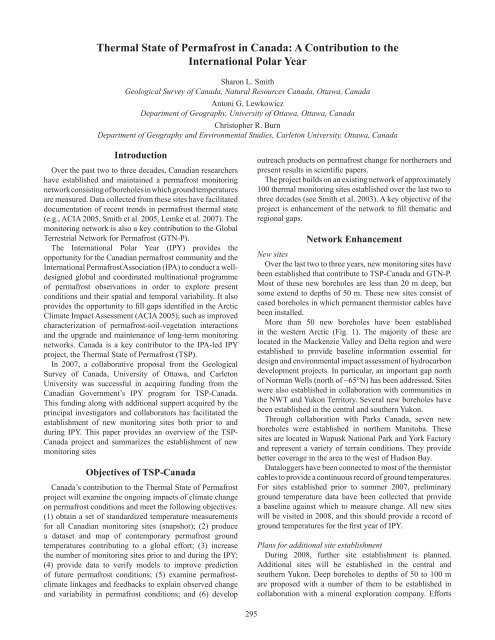Ninth International Conference on Permafrost ... - IARC Research
Ninth International Conference on Permafrost ... - IARC Research
Ninth International Conference on Permafrost ... - IARC Research
Create successful ePaper yourself
Turn your PDF publications into a flip-book with our unique Google optimized e-Paper software.
Thermal State of <strong>Permafrost</strong> in Canada: A C<strong>on</strong>tributi<strong>on</strong> to the<str<strong>on</strong>g>Internati<strong>on</strong>al</str<strong>on</strong>g> Polar YearShar<strong>on</strong> L. SmithGeological Survey of Canada, Natural Resources Canada, Ottawa, CanadaAnt<strong>on</strong>i G. LewkowiczDepartment of Geography, University of Ottawa, Ottawa, CanadaChristopher R. BurnDepartment of Geography and Envir<strong>on</strong>mental Studies, Carlet<strong>on</strong> University, Ottawa, CanadaIntroducti<strong>on</strong>Over the past two to three decades, Canadian researchershave established and maintained a permafrost m<strong>on</strong>itoringnetwork c<strong>on</strong>sisting of boreholes in which ground temperaturesare measured. Data collected from these sites have facilitateddocumentati<strong>on</strong> of recent trends in permafrost thermal state(e.g., ACIA 2005, Smith et al. 2005, Lemke et al. 2007). Them<strong>on</strong>itoring network is also a key c<strong>on</strong>tributi<strong>on</strong> to the GlobalTerrestrial Network for <strong>Permafrost</strong> (GTN-P).The <str<strong>on</strong>g>Internati<strong>on</strong>al</str<strong>on</strong>g> Polar Year (IPY) provides theopportunity for the Canadian permafrost community and the<str<strong>on</strong>g>Internati<strong>on</strong>al</str<strong>on</strong>g> <strong>Permafrost</strong> Associati<strong>on</strong> (IPA) to c<strong>on</strong>duct a welldesignedglobal and coordinated multinati<strong>on</strong>al programmeof permafrost observati<strong>on</strong>s in order to explore presentc<strong>on</strong>diti<strong>on</strong>s and their spatial and temporal variability. It alsoprovides the opportunity to fill gaps identified in the ArcticClimate Impact Assessment (ACIA 2005), such as improvedcharacterizati<strong>on</strong> of permafrost-soil-vegetati<strong>on</strong> interacti<strong>on</strong>sand the upgrade and maintenance of l<strong>on</strong>g-term m<strong>on</strong>itoringnetworks. Canada is a key c<strong>on</strong>tributor to the IPA-led IPYproject, the Thermal State of <strong>Permafrost</strong> (TSP).In 2007, a collaborative proposal from the GeologicalSurvey of Canada, University of Ottawa, and Carlet<strong>on</strong>University was successful in acquiring funding from theCanadian Government’s IPY program for TSP-Canada.This funding al<strong>on</strong>g with additi<strong>on</strong>al support acquired by theprincipal investigators and collaborators has facilitated theestablishment of new m<strong>on</strong>itoring sites both prior to andduring IPY. This paper provides an overview of the TSP-Canada project and summarizes the establishment of newm<strong>on</strong>itoring sitesObjectives of TSP-CanadaCanada’s c<strong>on</strong>tributi<strong>on</strong> to the Thermal State of <strong>Permafrost</strong>project will examine the <strong>on</strong>going impacts of climate change<strong>on</strong> permafrost c<strong>on</strong>diti<strong>on</strong>s and meet the following objectives:(1) obtain a set of standardized temperature measurementsfor all Canadian m<strong>on</strong>itoring sites (snapshot); (2) producea dataset and map of c<strong>on</strong>temporary permafrost groundtemperatures c<strong>on</strong>tributing to a global effort; (3) increasethe number of m<strong>on</strong>itoring sites prior to and during the IPY;(4) provide data to verify models to improve predicti<strong>on</strong>of future permafrost c<strong>on</strong>diti<strong>on</strong>s; (5) examine permafrostclimatelinkages and feedbacks to explain observed changeand variability in permafrost c<strong>on</strong>diti<strong>on</strong>s; and (6) developoutreach products <strong>on</strong> permafrost change for northerners andpresent results in scientific papers.The project builds <strong>on</strong> an existing network of approximately100 thermal m<strong>on</strong>itoring sites established over the last two tothree decades (see Smith et al. 2003). A key objective of theproject is enhancement of the network to fill thematic andregi<strong>on</strong>al gaps.Network EnhancementNew sitesOver the last two to three years, new m<strong>on</strong>itoring sites havebeen established that c<strong>on</strong>tribute to TSP-Canada and GTN-P.Most of these new boreholes are less than 20 m deep, butsome extend to depths of 50 m. These new sites c<strong>on</strong>sist ofcased boreholes in which permanent thermistor cables havebeen installed.More than 50 new boreholes have been establishedin the western Arctic (Fig. 1). The majority of these arelocated in the Mackenzie Valley and Delta regi<strong>on</strong> and wereestablished to provide baseline informati<strong>on</strong> essential fordesign and envir<strong>on</strong>mental impact assessment of hydrocarb<strong>on</strong>development projects. In particular, an important gap northof Norman Wells (north of ~65°N) has been addressed. Siteswere also established in collaborati<strong>on</strong> with communities inthe NWT and Yuk<strong>on</strong> Territory. Several new boreholes havebeen established in the central and southern Yuk<strong>on</strong>.Through collaborati<strong>on</strong> with Parks Canada, seven newboreholes were established in northern Manitoba. Thesesites are located in Wapusk Nati<strong>on</strong>al Park and York Factoryand represent a variety of terrain c<strong>on</strong>diti<strong>on</strong>s. They providebetter coverage in the area to the west of Huds<strong>on</strong> Bay.Dataloggers have been c<strong>on</strong>nected to most of the thermistorcables to provide a c<strong>on</strong>tinuous record of ground temperatures.For sites established prior to summer 2007, preliminaryground temperature data have been collected that providea baseline against which to measure change. All new siteswill be visited in 2008, and this should provide a record ofground temperatures for the first year of IPY.Plans for additi<strong>on</strong>al site establishmentDuring 2008, further site establishment is planned.Additi<strong>on</strong>al sites will be established in the central andsouthern Yuk<strong>on</strong>. Deep boreholes to depths of 50 to 100 mare proposed with a number of them to be established incollaborati<strong>on</strong> with a mineral explorati<strong>on</strong> company. Efforts295
















